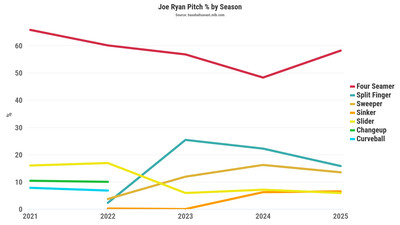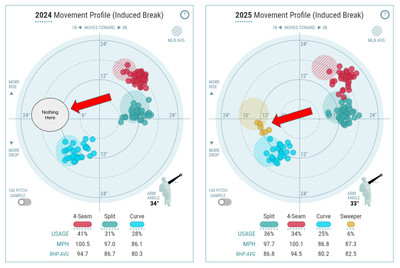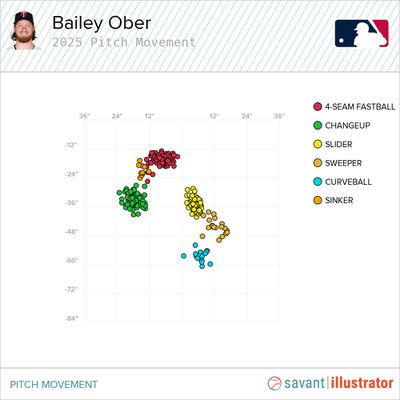
Which Twins pitchers are doing things differently than in the past?
Last week, I looked at some Twins’ hitters operating differently in this season’s early going. Today, let’s do the same with the pitchers.
Joe Ryan: Is Fastball Heavy Again
Despite Sunday’s clunker against Atlanta, Ryan has had a solid start to the season, with a 4.00 ERA, more than a strikeout per inning, and just three walks allowed over 27 innings. As this crowd knows, one of the things I monitor with Ryan is how often he’s using his secondary pitches. After breaking through to the majors as one of the more fastball-reliant starting pitchers in all of baseball, he’s worked hard to develop his splitter, slider, and sweeper and build the confidence to throw them in any count.
Before a shoulder injury ended last season prematurely, Ryan was on pace for a five-win season and threw his fastball less frequently than ever before. It was the first time in his career that his four-seamer made up fewer than half his offerings.

Visual from Baseball Savant
So far in 2025, he’s reverted to his fastball-heavy ways, throwing 58.2% four-seamers through five starts. If you include the sinker he often mixes in against right-handed batters, Ryan is operating with about 65% fastballs this season.
On one hand, we can take this as a sign that Ryan is feeling healthy and strong again, coming off the injury. And the four-seamer has generated good overall results, generating 1.4 Statcast runs per 100 pitches, which is right in line with last season. On the other hand, four of the five homers he’s allowed thus far have come off of four-seamers and sinkers, and his secondary pitches are what raise his ceiling from mid-rotation arm to potentially something more.
I wondered if that was influenced by the cold April temperatures that can make it difficult for pitchers to get a grip on offspeed and spin, but there doesn’t seem to be a pattern that correlates with temperature. At first pitch, three of Ryan’s five starts have had temperatures of 68, 74, and 80 degrees Fahrenheit.
Jhoan Duran: Has A Sweeper
Sometimes overlooked in the awe that comes with watching Jhoan Duran’s powerful arsenal is that his pitch mix can be somewhat predictable, especially in terms of pitch movement. I’ve written before that Duran’s four-seamer is more of a horizontal moving running fastball than the true vertical breaking four-seamer that we often think about with high-velocity four-seamers.
That horizontal break has increased over time as Duran’s arm angle has subtly lowered. That fastball movement, when paired with his splinker, which also has mostly arm-side horizontal movement, and his up and down curveball that has typically had below average horizontal glove-side break, has meant that Duran has never really had a pitch in his repertoire that moves primarily to his glove side (i.e., away from right-handed batters):

Visuals from Baseball Savant
The lack of a glove-side breaking pitch is perhaps the main reason why Duran has had reversed platoon splits. Right-handed batters have performed 32 points of wOBA better against him than left-handed hitters have since he debuted in 2022.
This season, he’s flashed a new sweeping breaking pitch that has about two times as much horizontal break as his curveball, while running at about the same velocity. (You can see it in the yellow dots on the right-hand side of the visuals above.) The public stuff models love it, with both Stuff+ and PitchingBot giving the sweeper above-average marks.
He’s thrown eight of them (just 6%) across his ten appearances, all to right-handed batters. The advantage of mixing in something to threaten that outer part of the plate, after everything else busts them inside, opens up pitch sequences and swings like this:
Jhoan Duran, 98mph Splinker (called strike) and 88mph (new) Sweeper/Sword, Overlay.
LOL. pic.twitter.com/wFFr2jbTXj
— Rob Friedman (@PitchingNinja) April 16, 2025
Louis Varland: Has a (Very) Viable Breaking Ball
One of the major challenges Louis Varland faced in trying to stick as a starting pitcher was his lack of swing-and-miss breaking stuff. Last season, Varland’s gyro slider was the second-worst performing slider (-10 runs) in baseball among the more than 400 pitchers who threw at least 50 sliders. His curveball was also significantly below average (-1.4 runs per 100 pitches). Both pitches were hit hard often and generated middling whiff rates, leaving Varland too fastball reliant and predictable.
So far this year, used exclusively as a reliever, Varland has favored his curveball of the two breakers, throwing it about a quarter of the time, and a little more often than that to right-handed batters. He’s cut his slider usage to about 10%.
It’s not the same curveball that he worked with previously, though. This one has about four more ticks of velocity than his starter version had. It’s now the hardest curveball in baseball, running in the upper 80s, with a sharp up-and-down movement profile as you can see here:
Opponents are 1 of 11 in at-bats ending on Louis’ revamped curveball, and they’ve whiffed on a huge 58.3% of their swings against it. That’s about twice the whiff rate he got with it last season, and its 25% hard hit rate allowed is about half last season’s mark.
Both pitch quality models grade Varland’s new hammer as well above average and significantly better than last year’s version. Now we’ll see if he leans into his new weapon, a la Griffin Jax when he was first adapting to full-time bullpen work.
Bailey Ober: A Sinker and Diminished Slider Velo
Big Bailey got rocked in his first start of the season for the second year in a row, but has looked more or less like his usual self over his next three starts. His seasonal numbers (6.16 ERA, 5.77 FIP) are ugly, but that’s going to be the case for a while.
I noticed two differences in Ober’s approach that are worth mentioning.
First, he’s thrown ten sinkers so far this season. That is something that he’s never done in the big leagues before. While he’s not as fastball-forward as teammate Joe Ryan, Ober is similar in that he also regularly works up in the zone with his four-seamer. Opposing hitters know this.
The league’s hitters have been steadily adjusting and performing better against elevated four-seamers, which has led many pitchers who rely on that pitch and location, including Ryan, to experiment with sinkers to offer a slightly different fastball look from the same trajectory and velocity band, but with a different movement profile and plate location.
These aren’t the Carlos Silva bowling ball sinkers for generating grounders, but instead something with just enough movement and difference from the four-seamer to miss a barrel or create hesitation to steal a called strike. They help keep hitters honest.

Visual from Baseball Savant
Ober’s new sinker (the orange dots in the plot above) has about 4 inches less vertical break (i.e., more drop) and about 7 inches more horizontal movement than his four-seamer, giving him something he can use against right-handed hitters who might be cheating up.
Its shape also fits nicely between his four-seamer and signature changeup, which might make it a useful bridge in the same way some pitchers use cutters to split the difference between their fastballs and horizontal breaking balls.
Change number two is that Ober’s slider, which he had pushed up to 86 mph and used more like a cutter last season, is back to looking more like a traditional slider, in terms of velocity and shape, this season.

Visual from Baseball Savant
It’s averaging 83.4 mph and has gained about 4 additional inches of vertical drop and an extra inch of horizontal movement. Those changes seem to have helped the pitch draw more whiffs (35%, up from 22.7%), but it’s also been hit very hard when put in play, with 2 homers, 2 doubles, and a 62.5% hard hit rate allowed.
Ober’s velocity has been a tick or two down across the board, which may be driving this as much as any intentional change. Nonetheless, I’d prefer to see his slider live in the mid-80s and his sweeping breaking pitch to sit around 80-81. The pitch quality models agree, grading his slider this season more harshly than last. Something to watch when he takes the bump against the White Sox tonight.
John writes for Twinkie Town, Twins Daily, and Pitcher List, with an emphasis on analysis. He is a lifelong Twins fan and former college pitcher.